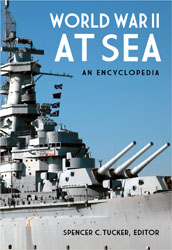| 03.07.2021, 07:40 | |||||
Автор книги: Spencer C.Tucker (Editor) Военно-морские силы играли важную роль с самого начала мировой истории. Они защищали территорию своей нации от морского нападения, делали возможным перемещение своей армии за границу и нарушали морскую торговлю противника, одновременно защищая собственную морскую торговлю и обеспечивая доступ к ключевым промышленным товарам и сырью. Тем не менее операции на море во Второй мировой войне имели беспрецедентный масштаб - гораздо масштабнее и важнее, чем в Первой мировой войне. С июня 1940 года по июнь 1941 года единственной крупной державой в войне с Германией и Италией была Британия. В это время происходила ожесточенная борьба за контроль над морскими путями - особенно в Атлантическом океане, а также на морских путях в Индию и Персидский залив. Битва за Атлантику была, по сути, самой продолжительной кампанией Второй мировой войны. Война также повлекла за собой десантные операции в гораздо большем масштабе, чем в любом предыдущем конфликте. Поражения как Германии, так и Японии стали возможны во многом благодаря таким операциям. Блокирование Голландской Ост-Индии лишило японский флот и Японию нефти и другого необходимого сырья. Захват Соединенными Штатами японских островов в центральной части Тихого океана сделал возможной стратегическую бомбардировку самой Японии. К концу войны японский флот был в значительной степени уничтожен, а международные перевозки по воде практически прекратились из-за действий подводных лодок, самолетов с авианосцев и воздушному минированию ВВС США. Кроме того, война привела к тому, что морская авиация стала доминирующей силой. Линкор, как царь морей, был свергнут авианосцем. Морские сражения, такие как в Коралловом море и Мидуэй, решались авианосцами, причем основные боевые флоты никогда не были видны друг другу. Война привела к появлению крупнейших в мире линейных кораблей "Ямато" и "Мусаси" с экипажами до 2500 человек, а также небольших пилотируемых торпед с экипажем всего из двух человек. Война подстегнула появление многочисленных технических новшеств: специально построенные десантные корабли; РЛС; торпеда Long Lance; противолодочные инновации, такие как сонар и др. США завершили войну с военно-морским флотом, который был больше, чем у всех других военно-морских держав вместе взятых (учтены британские, японские, немецкие и итальянские военно-морские силы). Navies have played an important role from early in world history. They have defended their nation’s territory from seaborne attack, made possible the movement of their nation’s armies overseas, and attacked enemy seaborne trade (the so-called guerre de course ) while defending their own nation’s waterborne commerce and access to key manufactured goods and raw materials. Yet operations at sea in World War II were on an unprecedented scale—far larger and more important than in World War I. The survival of Britain, which from June 1940 to June 1941 was the only major power at war with Germany and Italy, rested largely on control of the sea lanes—especially the Atlantic Ocean but also the sea lanes to India and the Persian Gulf. The Battle of the Atlantic was, in fact, the longest campaign of the Second World War. The war also entailed amphibious operations on a far greater scale and with a far greater degree of professionalism than in any previous conflict. The defeats of both Germany and Japan were made possible in large part by these assaults. Cutting off the Netherlands East Indies starved the Japanese fleet and Japan of oil and other essential raw materials. The U.S. capture of Japanese-held islands in the central Pacific made possible the strategic bombing campaign of Japan itself. The war also saw the United States emerge as the world’s greatest practitioner of submarine warfare. By the end of the war, the Japanese fleet had been largely destroyed, and interisland transportation by water had come to a virtual standstill thanks largely to submarines, carrier aircraft, and aerial mining by the U.S. Army Air Forces. Additionally, the war saw naval aviation come into its own. The battleship was dethroned as king of the seas by the fleet aircraft carrier. Naval battles such as the Coral Sea and Midway were decided by carrier planes with the main battle fleets never coming within sight of one another. The war saw the world’s largest battleships in the Yamato and Musashi with crews of up to 2,500 men as well as small manned torpedo craft with a crew of only two men. There were numerous technical innovations: purpose-built landing craft and ships; radar; the Long Lance torpedo; the proximity fuse; and such antisubmarine innovations as sonar, the Leigh light, and the Hedgehog. Although the United States ended the war with a navy larger than those of all the other world naval powers combined, the British, Japanese, German, and Italian navies all factored into the outcome. National leaders and naval commanders made decisions that had far-ranging repercussions. Entries in this encyclopedia discuss all these and more. There are entries on the national navies, ranging from the United States to Bulgaria; on leaders; on battles and campaigns; on the naval aspects of amphibious operations from the German invasion of Norway to the Allied invasions of France; on naval aircraft and on ship types, such as aircraft carriers, submarines, and battleships; on important individual ships; on naval weapons systems; and on technical innovations. | |||||
|
| |||||
| | | |||||
| Всего комментариев: 0 | |
